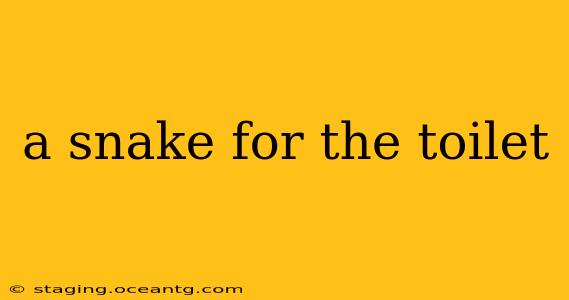A Snake in the Toilet: Understanding the Unpleasant Reality and Prevention
Finding a snake in your toilet is a terrifying experience, a truly unexpected and unsettling encounter. While rare, it's a problem that's surprisingly common enough to warrant understanding. This guide delves into the reasons why snakes might end up in your toilet, explores preventative measures, and offers advice on what to do if you face this unwelcome situation.
Why Are Snakes in My Toilet?
Snakes aren't deliberately seeking out your toilet for a swim; they're usually there by accident. Their presence usually boils down to a few key factors:
-
Plumbing Issues: A damaged or poorly sealed pipe can create an entry point for snakes seeking moisture, shelter, or prey. Cracks or gaps in the sewer line, especially older ones made of clay or cast iron, are particularly vulnerable.
-
Searching for Water: Especially during dry spells, snakes may be drawn to the moisture and potential water source that a toilet bowl offers.
-
Following Prey: Rodents, insects, and other small creatures sometimes find their way into sewer systems. A snake following its prey could unintentionally end up in your toilet.
-
Accidental Entry: A snake might accidentally enter through an open vent or a gap in the plumbing system, particularly in areas with significant snake populations.
What Kind of Snakes End Up in Toilets?
The type of snake found in your toilet will vary greatly depending on your geographical location. Common culprits often include small, non-venomous snakes that are attracted to moisture and dark spaces. However, encountering a larger or venomous snake is possible, though statistically less likely.
How Do I Prevent Snakes from Entering My Toilet?
Preventing a snake from slithering into your toilet is crucial for both safety and peace of mind. Here are some preventative measures:
-
Regular Plumbing Inspection: Schedule regular inspections of your plumbing system to identify and repair any cracks, gaps, or leaks.
-
Sealing Gaps: Seal any visible gaps or cracks around pipes and toilet connections with caulk or sealant.
-
Toilet Tank Lid: Ensure your toilet tank lid is always closed tightly to prevent entry.
-
Screen Vents: Install screens over any vents that lead to your sewer system to prevent snakes and rodents from entering.
-
Outdoor Prevention: Address potential snake habitats around your home. Keep your yard clean, remove debris and brush piles, and maintain a well-maintained lawn. This reduces the chances of snakes getting close to your house in the first place.
-
Consider Professional Help: For significant plumbing issues or persistent snake problems, consult a qualified plumber or pest control professional.
What Should I Do if I Find a Snake in My Toilet?
Finding a snake in your toilet is alarming, but here's how to handle the situation calmly and safely:
-
Stay Calm: Don't panic. Slowly back away from the toilet.
-
Close the Lid: Gently lower the toilet lid to prevent the snake from escaping.
-
Contact Animal Control or a Pest Control Service: These professionals are equipped to safely remove the snake from your property. Do not attempt to handle the snake yourself, especially if you don't know if it's venomous.
-
Document the Occurrence: Taking photos or videos can be helpful for later reporting to your insurance company or plumber in case there are underlying plumbing issues.
Can Snakes Climb Up Through the Toilet?
While it's extremely unlikely for a snake to actively climb up through the toilet from the sewer line, it's much more common for them to enter through gaps or cracks in the plumbing that leads to the toilet. The key is maintaining a well-sealed and regularly inspected plumbing system.
How Often Do Snakes Get in Toilets?
While rare, reports of snakes in toilets occur with enough frequency to be a recognized problem. The likelihood increases in areas with high snake populations and older plumbing systems.
This guide aims to equip you with knowledge and preventative measures to minimize the chances of encountering a snake in your toilet. Remember, prevention is key, and professional help is always the safest option when dealing with wildlife in your home.
